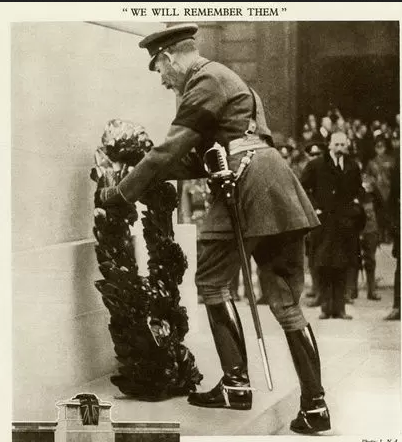greatwar-1914:November 11, 1919 - First Anniversary of the Armistice Pictured - King George V lays a
greatwar-1914:November 11, 1919 - First Anniversary of the Armistice Pictured - King George V lays a wreath for the fallen at the temporary Cenotaph in London.No conflict had ever affected so many millions of Europeans as the Great War. Out of the 70 million or so people mobilized during the war, 9.5 million had died. In some nations the war had almost literally wiped out a generation - in Britain, Turkey, and Serbia, for example, 60% of men between 20 and 30 years old had perished. The scale of suffering and grief on the continent was unprecedented, and the following years ushered in a series of new rituals of commemoration as people grasped for ways to cope with the loss of their comrades and loved ones. The victorious Entente powers had held their triumphs in the summer of 1919. The largest was on July 14, France’s fête nationale, when contingents of troops from each nation marched under the Arc de Triomphe to the thunderous applause of the Parisian crowd. But for many men and women there was a sense that it was not enough to celebrate the victory. Its price had to be remembered too. In London, the army paraded past an empty tomb known as a cenotaph, erected to commemorate the missing dead. And the French parade was led by a visible reminder of the war’s cost: a contingent of wounded veterans, the mutilés de guerre, described by an American correspondent :“Very many of the mutiles have one leg, one arm, one eye gone. Many are on crutches… Some cannot walk; some, with both legs gone, can never walk. These are wheeled on long, low chairs by the more able-bodied wounded or by nurses. Some of the mutiles are totally blind and are led by their comrades.”Jean Galtier-Boissière - Défilé des mutilés, 1919. While the triumphal parade was an ancient celebration of victory, the empty cenotaph foreshadowed new rituals of mourning. Industrial war disrupted many normal ways to cope with grief. It was impossible to hold to traditional funeral practices when so many bodies had been buried in anonymous graves at the front, or disappeared totally in mud and shellfire. The impossibility of finding solace in tradition made loss into a solitary and difficult experience for Europeans, but also led to the conception of new forms of commemoration. The first anniversary of the armistice witnessed the inception of many such new rituals. Many were spontaneous. In London thousands gathered at the victory cenotaph, which had been left up temporarily. By serving as a substitute for absent war graves, the empty tomb satisfied the urge of Britons who wanted some way to mourn their missing dead. The crowd was so thick that flowers and wreaths had to be passed up by hand to the memorial. The cenotaph’s architect Edwin Lutyens recalled that “it was a mass-feeling too deep to express itself more fitly than by piles of ever-fresh flowers which loving hands placed on the Cenotaph day by day.” Another new practice was a two-minute silence held at 11:00 AM, the hour that the armistice had been signed. After witnessing a moment of silence for the war dead in Cape Town that year, the South African Sir Percy FitzPatrick wrote to King George with the idea of making it an empire-wide practice. The King approved the idea and on November 7 issued a press statement asking his subjects that at 11:00 on the eleventh, “all work, all sound, and all locomotion should cease, so that, in perfect stillness, the thoughts of everyone may be concentrated on reverent remembrance of the glorious dead.“Newspapers across the British empire recorded how people stopped in silence that day. After a year spent grieving in isolation, the two minutes silence caused an outpouring of emotion. A Daily Mail correspondent wrote that “mill girls cried when the looms were stopped.” Mourning became something to be shared. The Manchester Guardian reported on the emotional public reaction.“The first stroke of eleven produced a magical effect. The tram cars glided into stillness, motors ceased to cough and fume, and stopped dead, and the mighty-limbed dray horses hunched back upon their loads and stopped also, seeming to do it of their own volition. Someone took off his hat, and with a nervous hesitancy the rest of the men bowed their heads also. Here and there an old soldier could be detected slipping unconsciously into the posture of ‘attention’. An elderly woman, not far away, wiped her eyes, and the man beside her looked white and stern. Everyone stood very still … The hush deepened. It had spread over the whole city and become so pronounced as to impress one with a sense of audibility. It was a silence which was almost pain … And the spirit of memory brooded over it all.”Road workers in London bare their heads for a moment of silence on the first Armistice Day. From the archives: the first anniversary of the Armistice was 101 years ago today. -- source link
#ww1 history#great war#history#armistice day#november 11
